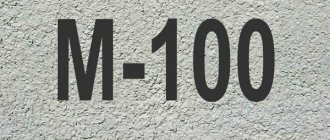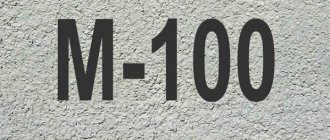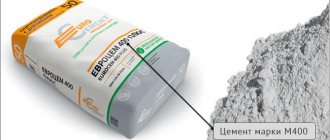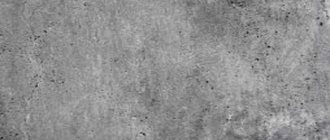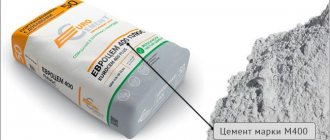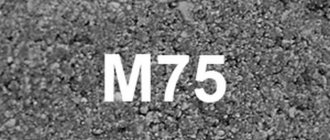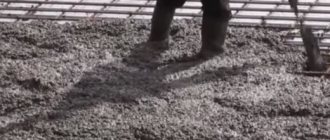Class B7.5 concrete is an inexpensive, lightweight type of concrete that is used in the construction of residential and public buildings and structures. It is used during preparatory work, for above-ground structures and where it is not economically viable to use a more durable type of concrete.
The composition contains a large amount of crushed stone, which explains the low strength index. At the same time, the strength class allows the use of concrete for reinforced concrete structures that are not subject to increased loads.
Lightweight concrete reduces the overall weight of building structures, the cost of construction work and reduces construction time.
Description and application V 7.5
Construction work involves the use of various types of ready-mixed concrete, the strength of which depends on the scope of their application. Lean mortars include liquid concrete of class B7.5 or grade M100.
The purpose of lean concrete is to create an insulating cushion for concrete solutions of a higher grade.
This ready-mixed concrete is fragile, but a cheap monolithic material; it is used only in areas not subject to high loads. Strength class B7.5 is suitable for use in the manufacture of reinforced concrete structures that are not subject to increased pressure. This is a permeable concrete solution; it forms a reliable barrier to the liquid fraction of the high-grade BST heavy concrete mixture. It has a low density, which reduces pressure on the soil.
Such characteristics as resistance to low temperatures and moisture, strength, determine the specific application of class B7.5.
Proportions and composition
To prepare concrete grade M100, you will need standard components - cement, sand, crushed stone and water. Sometimes additives such as plasticizers are used to improve quality or other fillers that reduce the density of this material.
Requirements for placeholders remain standard. The sand must be washed from a quarry or river; a gravel-sand mixture is allowed. The recommended crushed stone fraction is medium; limestone, gravel or granite material is used. This filler affects the strength indicator, since crushed limestone has a lower value of this value than granite. Water for concrete grade 100 is purified, without acids and salts dissolved in it.
The ratio of ingredients depends on what Portland cement is used for the solution. For the M400 cement grade, two options are offered in mass and volume fractions. In mass fractions per one part of cement, taken in kilograms, centners or tons, the following is taken:
- sand – 4.6 parts;
- crushed stone – 7.
For M500, the ratio of fillers changes; for one part you will need:
- sand – 5.8 parts;
- crushed stone – 8.1.
In volume fractions in cubic meters or in liters, fillers are taken for M400:
- sand – 4.1 parts;
- crushed stone – 6.1.
When using M500 cement for the production of M100 concrete, the composition for one part of the binder will be as follows:
- sand – 5.3 parts;
- crushed stone – 7.1.
The amount of water is adjusted to achieve optimal hardness and mobility of the solution.
To obtain one cubic meter of M100 concrete mixture with average performance from M400 cement you will need:
- cement – 250 kg;
- sand – 0.58 m³;
- crushed stone – 0.8 m³;
- purified water – 210 l.
It is taken into account that during construction, cement is taken in kilograms, and the remaining ingredients in volume fractions.
Concrete mixers are used to make the composition, since the quality directly depends on the thoroughness of mixing the components. In private construction, manual mixing is allowed.
Scope of application
Parameters influencing applicability: strength, moisture-resistant, frost-resistant characteristics.
The main areas of application of B7.5 include:
- concrete pads for the base, foundation on compacted, sandy soils. The cushions prevent the binding component from sinking into the ground. Such layers serve as an additional waterproofing barrier that protects the structure and fittings from rust;
- substrates for the main road surface during the construction of roads, pedestrian zones, and vehicle areas subject to high loads;
- Curbs and monolithic structures with low loads are cast from liquid BST B7.5, and infrastructure elements are installed on playgrounds for children and sports;
- pour subfloors in garages, sheds, workshops, cellars where there is no foundation.
Purpose
Concrete V7.5 (M100) belongs to the group of lean concretes, which are subsequently not subjected to significant loads, that is, they cannot form structures for any purpose. The main purpose of this material is to prepare for the installation of more durable materials:
- Strengthening the soil for laying the foundation;
- Fixation of underlying cushions under road surfaces, sidewalks, foundations;
- Construction of a subfloor on the ground under the finishing screed;
- Preparation of sites for storing construction materials on site;
- Landscaping of the local area, for example, laying garden paths and flower beds.
Concrete 7.5 grade 100 serves as a substrate for the reinforcement cages - rods are installed on it, after which working concrete of higher grades is poured.
Description of the main characteristics of class B7.5
The use of ready-mix concrete BSG is influenced by its parameters. For each batch of solution, documents must be issued that confirm its characteristics obtained in laboratory tests.
Parameters V7.5
- Strength – 98 kg/cm²;
- Density indicator - 2360-2400 kg/m³;
- Mobility (P2-P4);
- Retains its shape after installation (Zh2-G4);
- Moisture resistance – W2-W4, not used in high humidity;
- Frost resistance – F50-F100 (the range is affected by additives);
- Weight – 1850 kg.
The parameters listed above provide monolithic concrete with high applicability. The material belongs to the light category if expanded clay is used as a filler in its composition.
Technical characteristics of concrete
Concrete type B7.5 is not used in rooms with high humidity. It is also not used in soil with high water levels or seasonal flooding.
Characteristics of ready-made concrete:
- density - no more than 1900 kg/m3, therefore withstands pressure of 98 kgf/cm2;
- water resistance – W2; W4 (the first indicator is for a limestone filler; the second is for a granite filler);
- frost resistance – F50, means that concrete can withstand up to 50 cycles of freezing and thawing;
- The mobility of concrete ranges from P2 to P4 - the less water is used during mixing, the less mobility of the composition.
The best conditions for hardening the composition are: air temperature +20, +22 degrees Celsius and humidity 90%. At lower temperatures, concrete will harden more slowly. An optimal level of humidity must be maintained.
Factory production
The concrete mixing unit in Moscow produces concrete mixtures and cement mortars in accordance with GOST 25820 and GOST 7473 in compliance with the necessary requirements and technology. Buy lightweight concrete with expanded clay M100 or heavy concrete mix BST M100 without intermediaries from RBU in Moscow.
This is a light type of concrete in terms of specific gravity, especially when using expanded clay as a filler. Some characteristics can be improved with the help of a plasticizer or additives, for example, mobility or frost resistance. But for this class of concrete they are rarely used due to the increase in cost per cubic meter, which makes it more expedient to purchase concrete of a higher class.
Production technology
In factory conditions, concrete is produced in accordance with the requirements of GOST 7473.
- Crushed stone from limestone, granite, gravel, and dolomite is used as filler.
- The amount of liquid may vary depending on the moisture content of the sand and crushed stone. Therefore, a smaller amount of water is added at first and more is added if necessary.
To increase the level of frost resistance, special additives are introduced into the mixture - they are added when mixing concrete.
Stages of concrete production:
- cleaning and preparation of components;
- mixing dry mixture;
- mixing with water.
At the first stage, the dry components: sand, crushed stone are washed separately, dried, and then sifted. This allows you to remove residual clay, silt and other impurities that adversely affect the quality of concrete. After this, cement is added - it must be fresh with a minimum shelf life.
At the second stage, all dry ingredients are thoroughly mixed in a mixer to create a homogeneous mixture.
At the third stage, mix the dry mixture and water. In factory conditions, this process is mechanized, mixing is carried out in mixers (there are forced and gravity - the first option provides more efficient mixing of components). Concrete is delivered to the construction site on a concrete truck.
Strength test
The class of concrete is determined during laboratory tests based on strength indicators. To do this, cube-shaped samples are placed under a special press and subjected to loads. In this case, the load is constantly applied until the sample fails. The amount of damage to the sample and the presence of additional impurities are inspected. Samples are taken according to table No. 4 DSTU B V.2.7-214:2009.
Cost of concrete M100
The price of concrete prepared on your own consists of the cost of the components and the cost of electricity spent to operate the concrete mixer. If you prepare concrete according to the old method - on a sheet of iron, the last factor can be ignored. The last factor can be ignored. To calculate the cost of 1 m3 of M100 concrete, we will set the average prices for the most affordable Portland cement M400 packaged in 50 kg bags, quarry sand and granite crushed stone:
- Average cost of one 50 kg bag of M400 cement: 230 rubles.
- Average cost of 1 m3 (1.4 t) of quarry sand: 200 rubles. (0.14 rub./kg).
- Average cost of 1 m3 (1.4 t) of granite crushed stone: 1,750 rubles. (1.25 rub./kg).
Using the component consumption data from Table 1, we calculate how much the M100 solution prepared on our own will cost: (175/50)x230+(755X0.14)+(1150x1.25)=910+105.7+1437=2,453 rubles.
For comparison, the cost of M100 concrete ordered at a concrete plant is from 2,850 to 3,680 rubles, depending on the filler (gravel or granite) and the manufacturer. Due to the significant dependence on distance, the delivery of components and ready-mixed concrete was not taken into account.
New measures to support families with children from 2022
From 2022, the Pension Fund will begin to provide Russians with separate support measures, which in 2022 will be prescribed by the social protection authorities and Rostrud.
Today, different categories of citizens receive the measures transferred to the fund. For example, families with children and those preparing for their arrival. Parents are provided with monthly and one-time benefits, including payments for pregnancy, birth or adoption, as well as child care.
A large group of payments consists of benefits and compensation to the families of deceased military personnel and law enforcement officers. For example, compensation for utility bills, payments for the renovation of a private house or for a child’s summer recreational holiday.
Proportions of concrete M100
For the convenience of user-developers, we summarize the proportions of the components and their quantities required to prepare 1 meter of cubic material in the following table:
Table 1.
| Cement brand | Proportions C:P:SH:H | Number of components for preparing 1 m3 of concrete | |||
| Cement, kg | Sand, kg | Crushed granite, kg | Water, l | ||
| M400 | 1:4,4:6,8:1,1 | 175 | 755 | 1150 | 190 |
| M500 | 1:5:7,3:1,2 | 158 | 770 | 1150 | |
At a construction site, it is not always possible to measure concrete components in kilograms. Therefore, “by default”, when preparing a batch, developers use a universal “measure” - a “bucket”. That is, they measure the proportions of concrete in 100 m buckets. We bring the data in Table 1 to a “10 and 12 liter bucket” and summarize them in Table 2:
Table 2.
| Cement brand | Number of components for preparing 1 m3 of concrete in 10 liter buckets, pcs. | Number of components for preparing 1 m3 of concrete in 12 liter buckets, pcs. | ||||||
| Cement | Sand | Crushed stone | Water | Cement | Sand | Crushed stone | Water | |
| M400 | 13,5 | 54 | 82 | 19 | 11,2 | 45 | 68,5 | 15,8 |
| M500 | 12,2 | 55,3 | 82 | 10,1 | 45,8 | 68,5 | ||
When calculating the “buckets”, the following average reference values for the bulk density of materials were used:
- Cement: 1,300 kg/m3.
- Sand: 1,400 kg/m3.
- Crushed stone fraction 20-40 mm: 1,400 kg/m3.
Benefits for children under 3 years of age
The payment, which was initially dubbed the “Putin benefit,” is intended for low-income families. Now the bar is set at two general subsistence levels. The monthly wage per capita in 2022 is 12,654 rubles; accordingly, the benefit will be assigned if, when dividing all income by all family members, the result is less than 25,308 rubles per person . This is the national average; the cost of living will differ in each region.
The payment is paid only for the first and second children. The first is paid from the budget, the second - from maternity capital.



